What Is a MOV File
MOV is a video format released by Apple in 1998. This format was developed specifically for QuickTime. But now, it is also used in many non-Apple operating systems, streaming platforms, and social media.
A MOV file contains separate multimedia tracks, including video, audio, and subtitles. This feature makes this format suitable for video editing. What’s more, MOV is widely compatible. It is supported by many streaming websites, like YouTube and Vimeo. Therefore, MOV is also the preferred format for many video creators.
Why You Should Convert MOV to Text
Why is video transcription a must? Here’s why you should convert MOV and other video files to text.
1. Make Your Video Content Accessible
Converting your MOV video to text makes your video content easy to reach. Compared to video, text is easier to understand quickly. For people with hearing impairments, transcribing videos into text can make them easier to watch and help them understand the content.
2. Unlock Content Repurposing
For content creators, transcription can maximize the use of your video content. Once you have the video transcripts, you can edit them and then publish them as blog posts on text-sharing platforms such as WordPress.org, Squarespace, and Medium.
3. Enhance Comprehension and Learning
Many video learning resources come with subtitles or provide transcripts. This helps learners understand the knowledge. Furthermore, listening to the video while reading the transcripts is especially helpful for language learning.
In addition, transcribing the learning videos into text makes reviewing easier. You no longer need to watch videos, simply browse the text to quickly review the key points. The document is also more conducive to note-taking.
4. Simplify Translation and Localization
Once the video is converted into a text file, translate it into multiple languages effortlessly using translation tools. This way, you can reach more international audiences without producing new videos.
Now that you understand the benefits of transcription, it’s time to choose a suitable transcription tool to convert MOV to text. How to choose a good tool that fits your needs? I will list some key factors to consider in the next part.
Which Transcription Tool Should You Use
To choose a video transcription tool that suits you best. You can consider the following factors:
1. Transcription Speed
An excellent transcription tool has high transcription speeds. Faster speeds allow you to complete transcription tasks in a very short time, saving you valuable time.
2. Transcription Accuracy
Besides transcription speed, transcription accuracy is also a crucial factor. A good MOV to text converter has a powerful AI model that can accurately transcribe text. High-precision transcription tools can reduce editing and proofreading, thereby improving work efficiency.
3. Language Support
The transcription tool you choose needs to support multiple languages. This ensures transcribing your videos in different languages successfully. A good transcription tool can even automatically identify the language of a video, even if you don’t know what language the video is in.
4. File Format Support
The transcription tool you choose should support importing multiple video formats, such as MOV. It should also support exporting multiple text formats, such as TXT, SRT, and VTT, to meet your needs.
Confused about text format options? Keep reading to discover which format works best for subtitles, documentation, or web captions.
Which Text Format Should You Choose
If you don’t know which text format to choose, refer to the following common text formats and their usages:
- SRT: A plain text file format that includes subtitle sequence number and start/end timecodes. It is used to display subtitles for the video.
- VTT: A subtitle format that contains the font, color, position, and styling of the text. It is usually used to display styled subtitles for HTML5 video players on websites.
- TXT: A plain text file format that only includes transcribed speech. It doesn’t have timestamps and is usually used for quick reading.
- Docx: A Word document format that includes timestamps. It is used for creating editable and formatted transcriptions.
You need to choose the appropriate text format to ensure compatibility with various platforms and use cases. Now, let’s learn how to convert MOV files to the text format you want.
How to Convert MOV to Text
Although manual transcription is more accurate, converting video into text using AI-powered transcription tools is more efficient. Here are 3 tools to help you transcribe MOV to text.
1. MiniTool Video Converter
MiniTool Video Converter is a professional video/audio-to-text converter. It allows you to convert videos to popular text formats like TXT and SRT. Also, it gives you 3 AI models to choose from: basic model, standard model, and advanced model. All of them can accurately and quickly transcribe your video or audio. You just need to select one according to your needs.
MiniTool Video Converter supports many formats, including MP4, MKV, MOV, AVI, MP3, WAV, M4A, AIFF, and more. Plus, this application is completely free of ads, bundles, or watermarks.
Learn how to transcribe MOV to text with MiniTool Video Converter with these steps:
Step 1: Download and Install MiniTool Video Converter
Click the button below to download MiniTool Video Converter for your Windows PC.
MiniTool Video ConverterClick to Download100%Clean & Safe
Step 2: Choose an AI Model
Launch this free MOV to text converter. In the left column, switch to the Intelligent Subtitle tab. Then, click the Choose Video option to open the Choose AI Model window. Next, select the model you want and click OK.

Step 3: Import MOV File
After you select the desired AI model, the Import Media window will automatically pop up. Select the MOV file you want to transcribe and click Open to import it to MiniTool Video Converter.
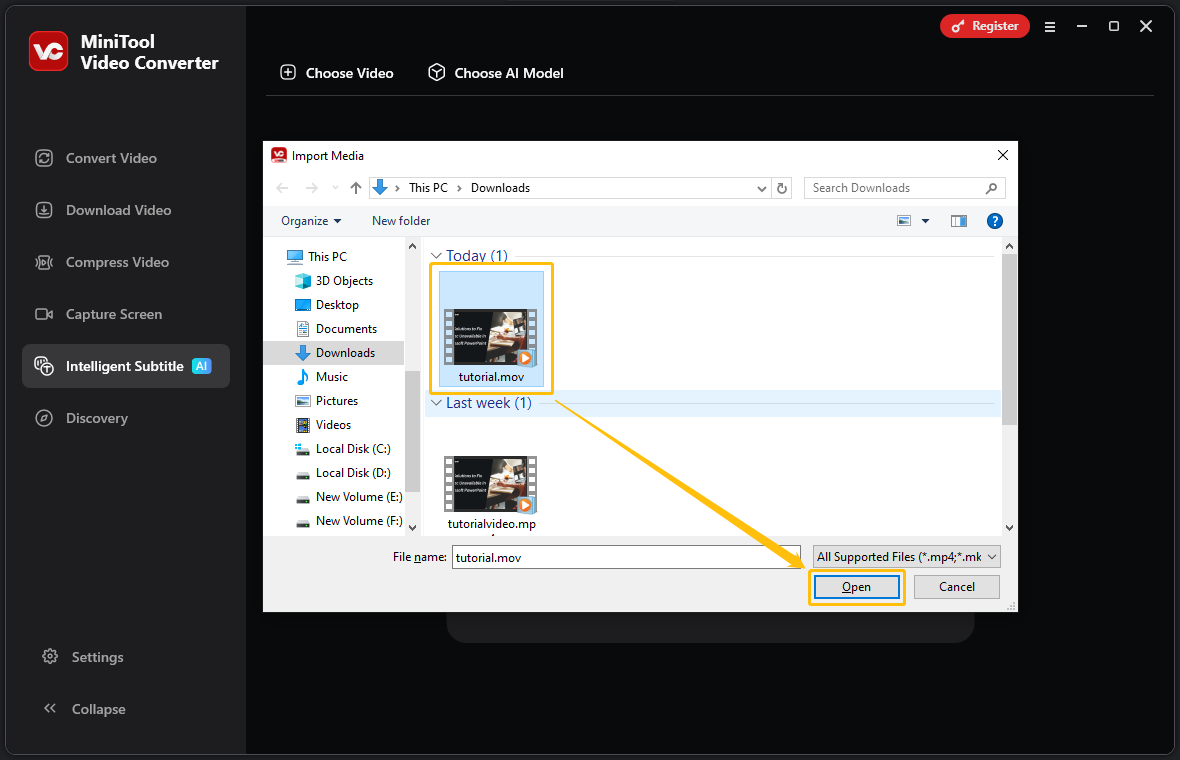
Step 4: Edit the Text
In a few seconds, the software will convert your MOV file into text. You can view this text in the right panel of the interface. If necessary, click the edit button next to each sentence to modify it.
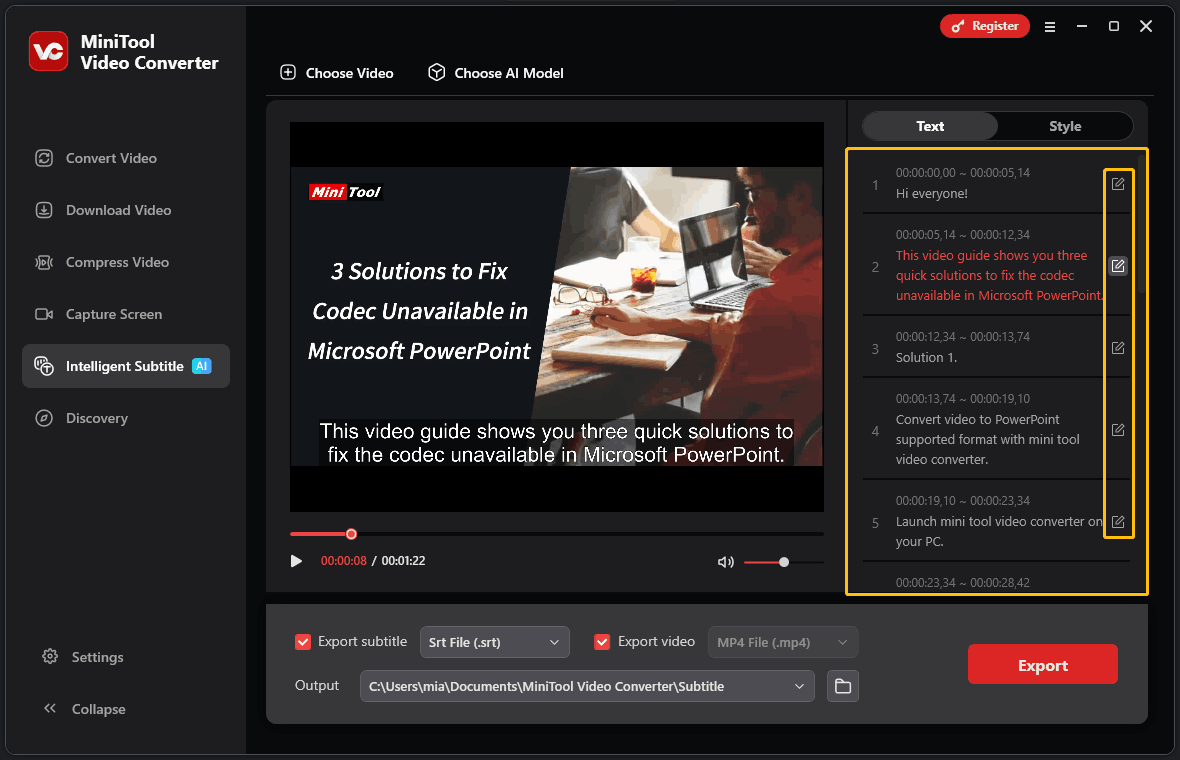
Step 5: Choose Output Text Format
Expand the Export subtitle option and select the output text format (SRT or TXT).
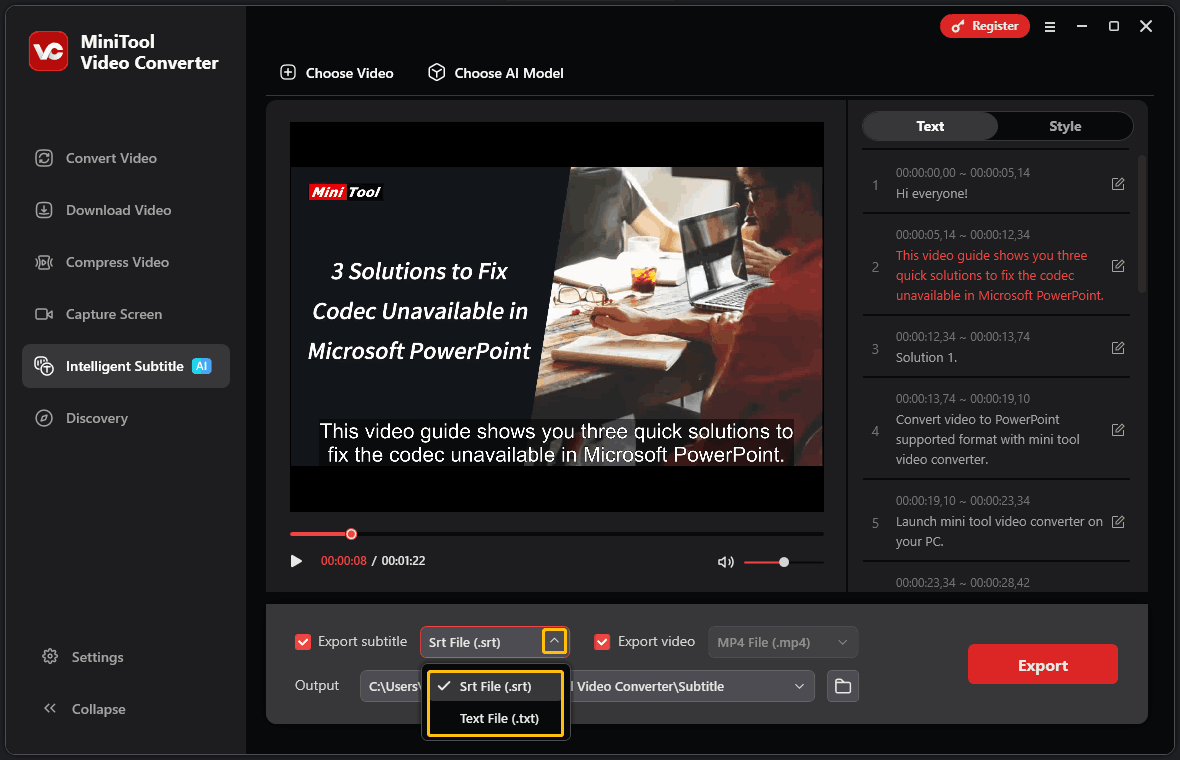
Step 6: Set the Save Location
Expand the Output option and choose a folder to save the exported text file.
Step 7: Export the Text File and Check It
Click on the bottom-right Export button to export the text file. Then, the output folder will pop up automatically. Double-click the exported file to check it.
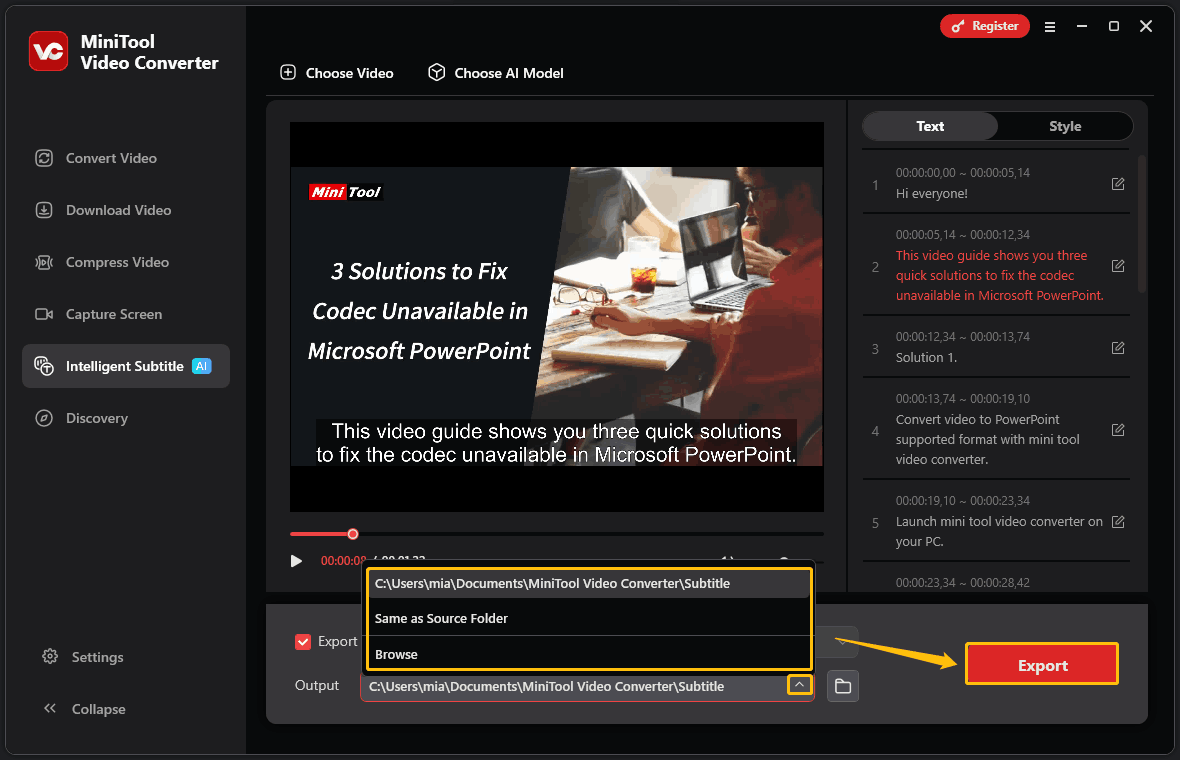
MiniTool Video Converter makes converting MOV files to text fast and effortless. It is also a free video converter that handles conversion between various video and audio formats. What’s more, it supports compressing videos with customizable quality.
2. Clipchamp
Clipchamp is a popular free video editor developed by Microsoft. As well as supporting all the basic functions of video editing, it provides a variety of features to help with editing, including video-to-text conversion. Furthermore, Clipchamp supports importing MOV videos. Therefore, you can use it to convert MOV files to text.
Clipchamp is built into Windows 11 devices. What’s more, it also provides an online version that is compatible with many web browsers, including Microsoft Edge and Google Chrome.
How to transcribe MOV to text with Clipchamp on your computer? Here are the steps:
Step 1: Launch Clipchamp
Windows 11 users can launch Clipchamp straight from the Start menu. Windows 10 users need to install this application from the Microsoft Store first.
Step 2: Create a New Project
Click the Create a new video option to go to the Clipchamp video editing interface.
Step 3: Import the MOV File
Click the Import media button in the upper-left corner. Then, select the MOV video you want to transcribe, and click Open.
Step 4: Add the MOV Video to the Timeline
Click the plus icon (Add to timeline) to add the video to the timeline. You can also directly drag and drop the video to the timeline.
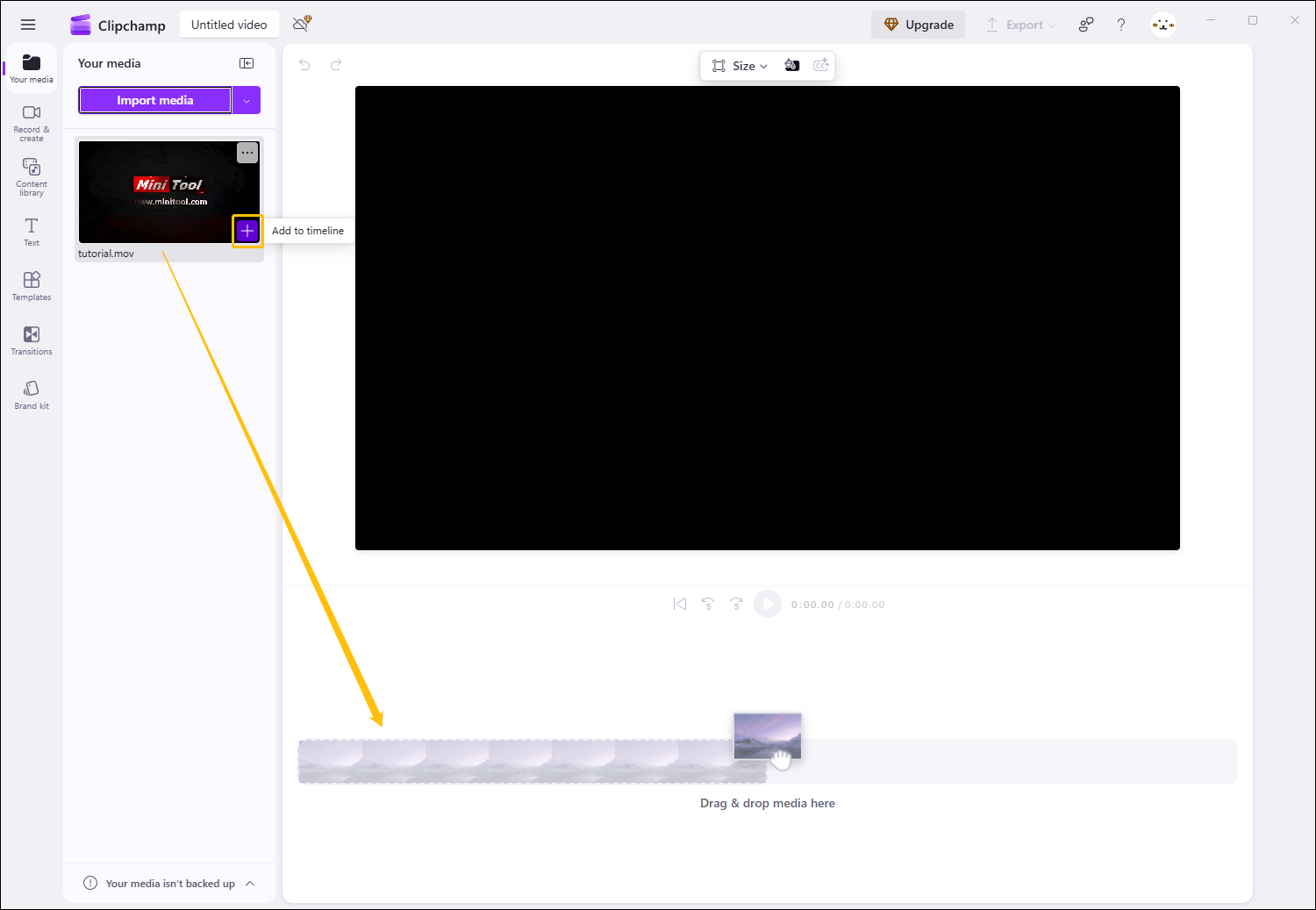
Step 5: Choose the Video Language and Start Transcription
Click the Captions option at the top-right corner and choose Try now.

In the pop-up window, select the video language, and click on Transcribe media.

Step 6: Download Video Captions
After the video transcription is completed, click Download captions (SRT) to save the text to your computer.
Step 7: Open the SRT File
Click the Open file option to open the SRT file.
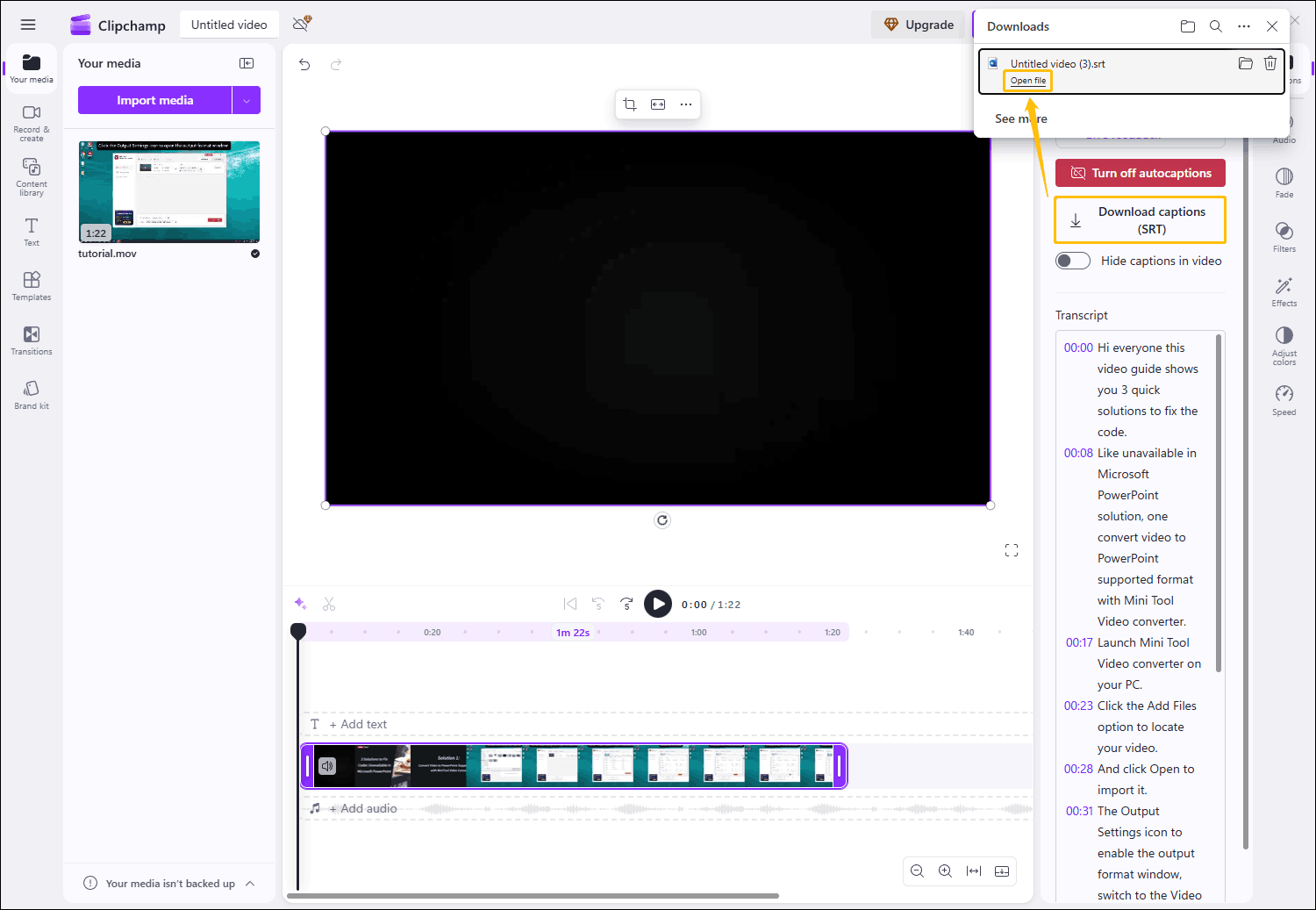
Clipchamp successfully converts video files to SRT format for free, delivering quite accurate transcripts. Both the desktop and online versions of Clipchamp have noticeably slow transcription speeds. If you need to transcribe videos quickly, try TurboScribe, an online tool with fast transcription speeds.
3. TurboScribe
TurboScribe is a tool specifically designed for transcription. It enables you to convert videos in a variety of formats, such as MOV, MP4, WAV, WMV, and WMA, into text. It also offers versatile export options, including TXT and SRT.
You can use TurboScribe for free. Its free version allows you to transcribe up to 3 videos or audio files each day, each under 30 minutes. If you need to transcribe many video files, you can upgrade to a paid service. With a paid TurboScribe plan, there are no file size limits.
How to convert MOV to text with TurboScribe? Simple steps are here:
Step 1: Go to the TurboScribe Dashboard
Visit https://turboscribe.ai/ to go to the interface of this MOV to text converter. Then, click the LOG IN button and sign in with your Google account.
Step 2: Access the Transcription Feature
Click the TRANSCRIBE FILES button.
Step 3: Upload the MOV File
In the Transcribe Files window, click the BROWSE FILES option to upload the MOV file you want to transcribe.
Step 4: Choose the Video Language
Expand the Audio Language option and choose the video language.
Step 5: Choose the Transcription Mode
Choose the transcription mode you like. From Cheetah to Whale, transcriptional accuracy gradually increases.
Step 6: Start Transcribing
Click the TRANSCRIBE button to start transcribing.
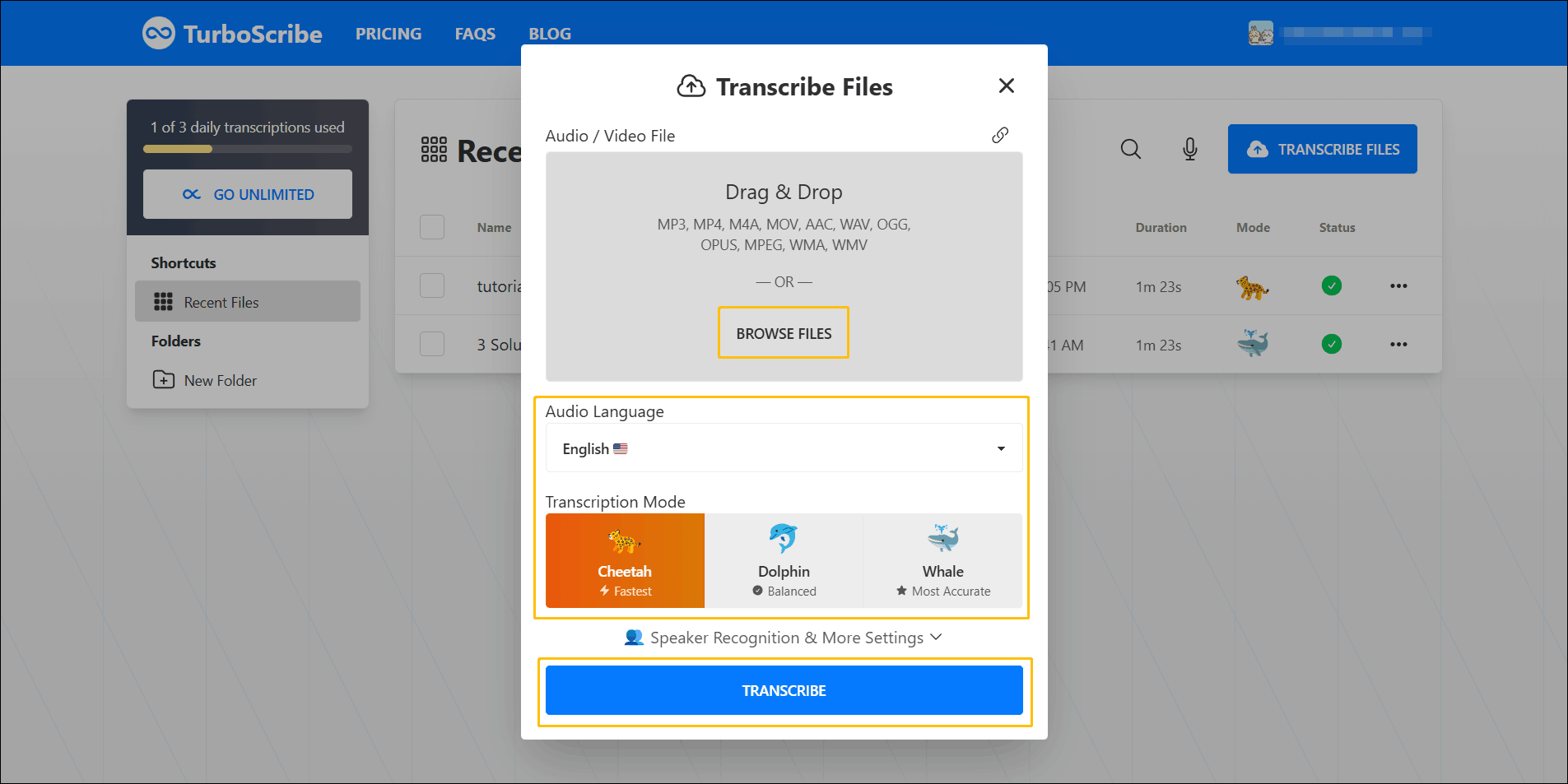
Step 7: Download the Transcript
A green check mark in the Status column means transcription is completed. Click the more icon and select Export Transcript from the dropdown menu to download the transcript.
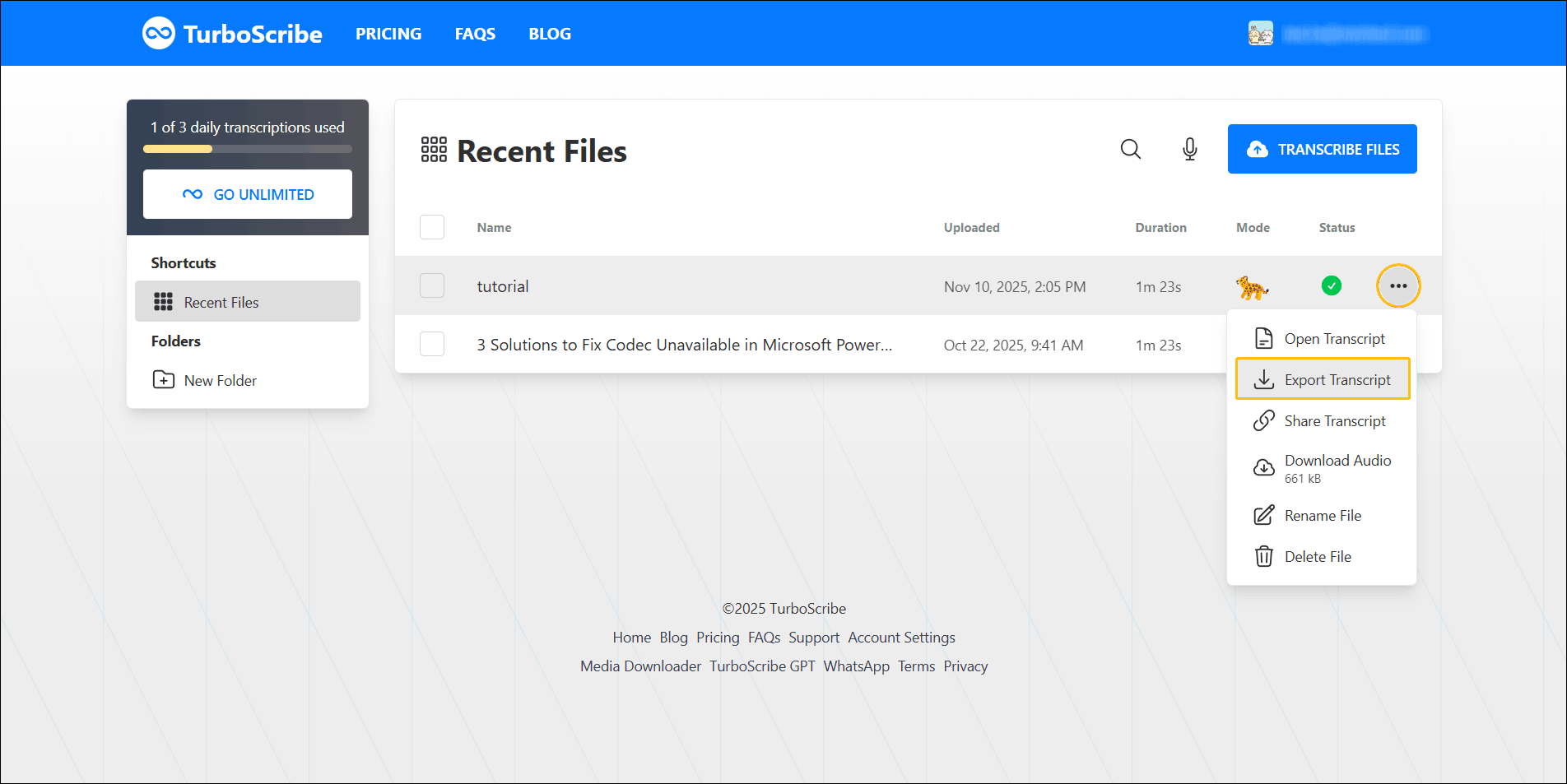
TurboScribe has an intuitive and easy-to-use interface. However, its free version has strict limitations: users can only transcribe 3 files per day, which is insufficient for those who want to transcribe multiple video files.
Bonus: How to Add Subtitles to Your MOV Video
Want to add captions to your MOV videos? It’s easy! MiniTool Video Converter can not only convert videos to text, but also generate video subtitles. How to do that? Here’s a guide:
Step 1: Import Your MOV File
Go to the Intelligent Subtitle tab of MiniTool Video Converter. Then click Choose Video to import your MOV video.
Step 2: Edit the Generated Subtitle
In the right panel, click the edit icon to modify the text if necessary.
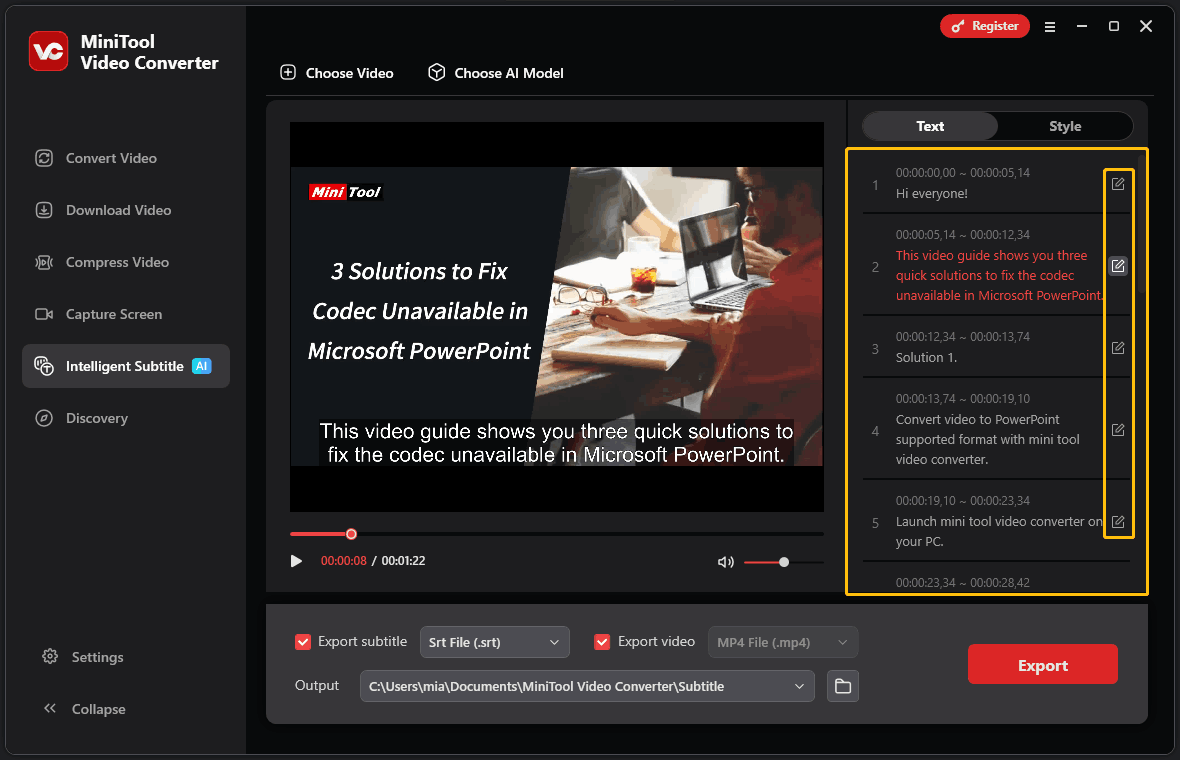
Switch to the Style tab. Then, you can adjust the font, color, size, opacity, background color, and position of the subtitle.
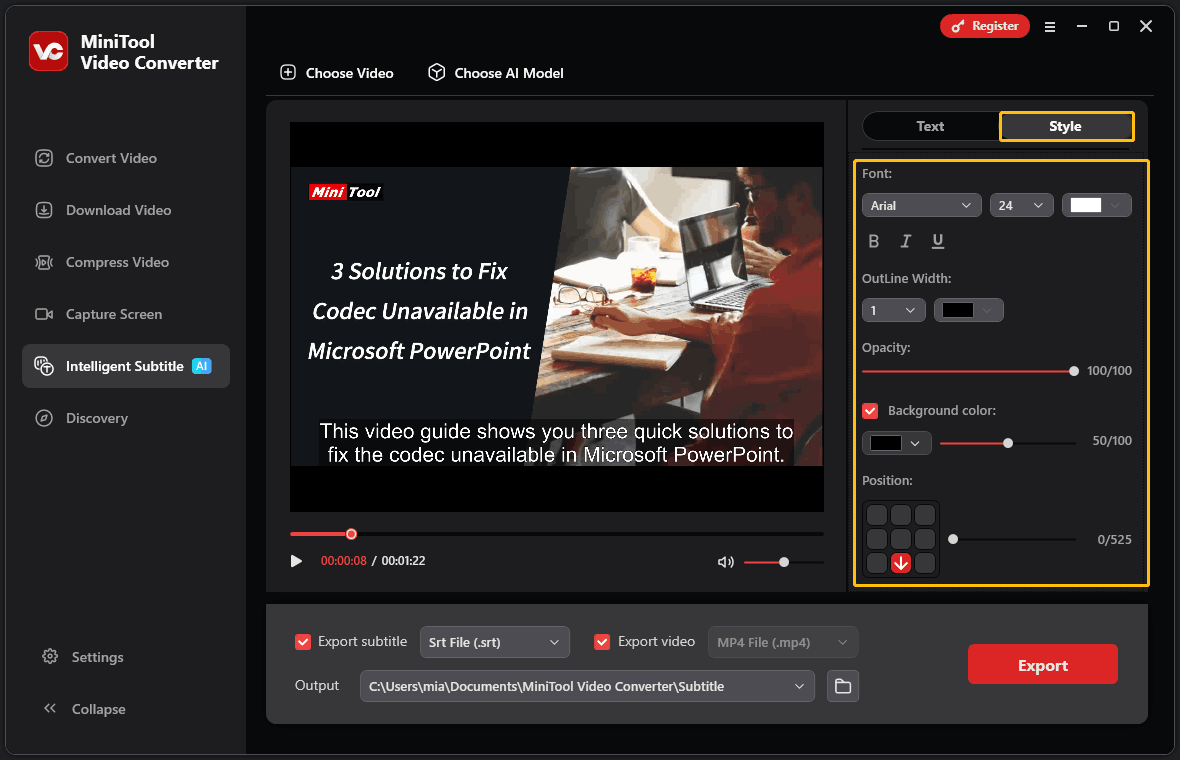
Step 3: Set the Save Location
Check the Export video option. Then, click the Output option and select a folder to save the exported video.
Step 4: Export the Video
Click the Export option. Then, you will see the exported video file in the next pop-up window.

By following the straightforward steps outlined above, you can quickly and effortlessly generate accurate, customizable subtitles for your MOV videos.
Final Words
Converting your video to text can not only enhance content accessibility, but also be conducive to content reuse. This post lists 3 transcription tools that allow you to convert MOV to text.
MiniTool Video Converter allows you to transcribe MOV to text quickly. Clipchamp supports converting video to an SRT file. And TurboScribe is an online tool specifically designed for transcription, which is suitable for fast transcription. Both Clipchamp and TurboScribe have a video file size limit. MiniTool Video Converter does not limit the upload size of your files.
If you have any problems when using MiniTool Video Converter, please send an email to [email protected] to ask for help. Also, you can directly send me a message on X. I will help you as quickly as possible.


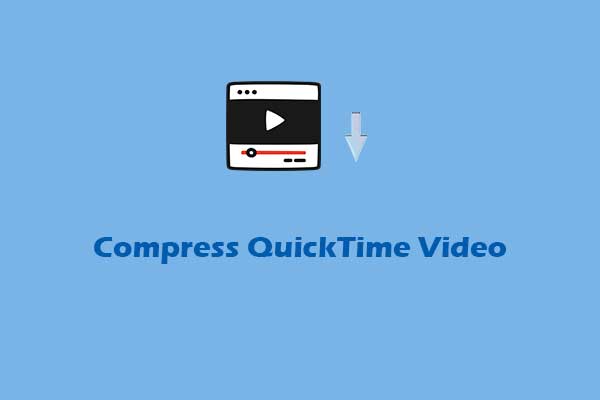
User Comments :